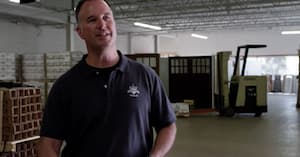Joey Fransway, manager of Clopay’s wood door manufacturing facility in Auburn, Washington, explains how selecting the right wood species for your home and opting for a pre-finished door can help alleviate maintenance concerns.
What are some of the most common wood door species and the advantages of each?
Many people mistakenly perceive wood to be a low-durability material. Wood has tremendous natural strength, inherent insulating properties and is a renewable resource. A properly finished and maintained wood door can last a long time – even as long as a door constructed in steel.
Some of the more popular species choices for wood door construction are Hemlock, Cedar, Spanish Cedar, Fir, Redwood, and Meranti. In the custom market, we are seeing more requests for specialty woods like Knotty Alder, Ironwood and Knotty Cedar, which yields a more distressed, rustic appearance versus the pristine, smooth and seamless look of the more common grains.
Are there situations where wood doors are not recommended?
Hot, dry, sunny climates are not kind to wood doors. Temperature fluctuations cause the wood to swell and contract and the finish breaks down much faster due to exposure. Salt air has a similar effect.
Cedar performs well in almost any environment, including rainy, humid climates. Redwood is another good option for regions with a lot of moisture.
What is the benefit of factory-finishing over field finishing?
Most wood garage doors are shipped in their natural state, ready to stain or paint prior to installation. Factory-finished doors arrive ready to install, eliminating the hassle of scheduling a contractor to complete the job on site. You have peace of mind knowing that the door is stored and finished properly to meet specific warranty guidelines, for a durable, flawless, vibrant finish.
Clopay wood garage doors and windows are sanded, caulked and finished on all six sides under controlled conditions, using Sikkens stain, which is considered to be the highest quality and most durable exterior stain finish system on the market. The finish is backed by a two year limited warranty.
What should a homeowner look for when choosing a wood door manufacturer?
Look for a manufacturer that actually makes wood garage doors in-house. They are often better equipped to assist customers in selecting the right wood species and design options for a particular project and location since they have the expertise to construct the doors to the exact specifications.
Clopay Reserve Collection Limited Edition Series and custom wood doors are built with exacting detail and craftsmanship by skilled artisans using our proven 4-layer construction method and finishing techniques for exceptional beauty, durability and energy efficiency.
Describe the best practices for finishing a wood door.
Improper finishing is enemy number one to the beauty and longevity of a wood garage door. To protect it, the door must be completely finished on all six sides prior to installation. All gaps and voids should be filled with a paintable or stainable caulk, depending on the finish application.
When painting a door, you can use either exterior latex or oil based primer and paint. (Most manufacturers offer factory priming, typically a latex paint, so the finish coat must also be latex.) When staining, choose an exterior grade stain and finish it with a UV protecting top coat.
The beauty of staining a wood door is that no two doors will look exactly alike because of natural grain variations. The same principle applies to finishing. The finish appearance will vary based on the interaction of the wood species and the stain color penetration.
Wood doors are not wood floors. Varnishes and urethanes are not recommended because they seal the wood instead of allowing it to breathe. This can trap moisture behind the finish and lead to warping, rotting or cracking over time.
Tannins are naturally occurring materials found in species like cedar and redwood. They act as barriers for micro-organisms like bacteria and fungi, which is good for the wood, but bad for the finish. To avoid the appearance of a yellow or light brown hue, use a Tannin blocker primer when working with those types of species.
Natural exterior wood products do require more maintenance. But if proper finish recommendations are followed, the maintenance is usually limited to re-applying a topcoat finish every 2 to 3 years without sanding or scraping. This process generally takes no more than an hour or two.
Answer these questions to find the best material and construction to ensure the long-lasting beauty of your Clopay wood garage door.
1. Do you live in a humid or rainy climate? Consider a Cedar or Redwood door for its durability and climate resistance.
2. Do you plan to paint your door? MDO and MDF panels provide a grain free surface for a smooth flawless finish.
3. Do you want to match an existing stain? Hemlock is the best choice.
4. Do you live in a coastal region? Local building code requirements may mandate a Hemlock stile and rail construction on doors over 10’ wide.
5. Do you have or are you installing Redwood or Cedar siding on your home? Consider a matching wood species for your door to create a cohesive appearance.
From These Aren’t Your Grandfather’s Wood Garage Doors by Clopay, May 9, 2012.
One Clear Choice Garage Doors is the only authorized Clopay dealer in Denver. Call One Clear Choice Doors for advice on what garage door is best for your home.










